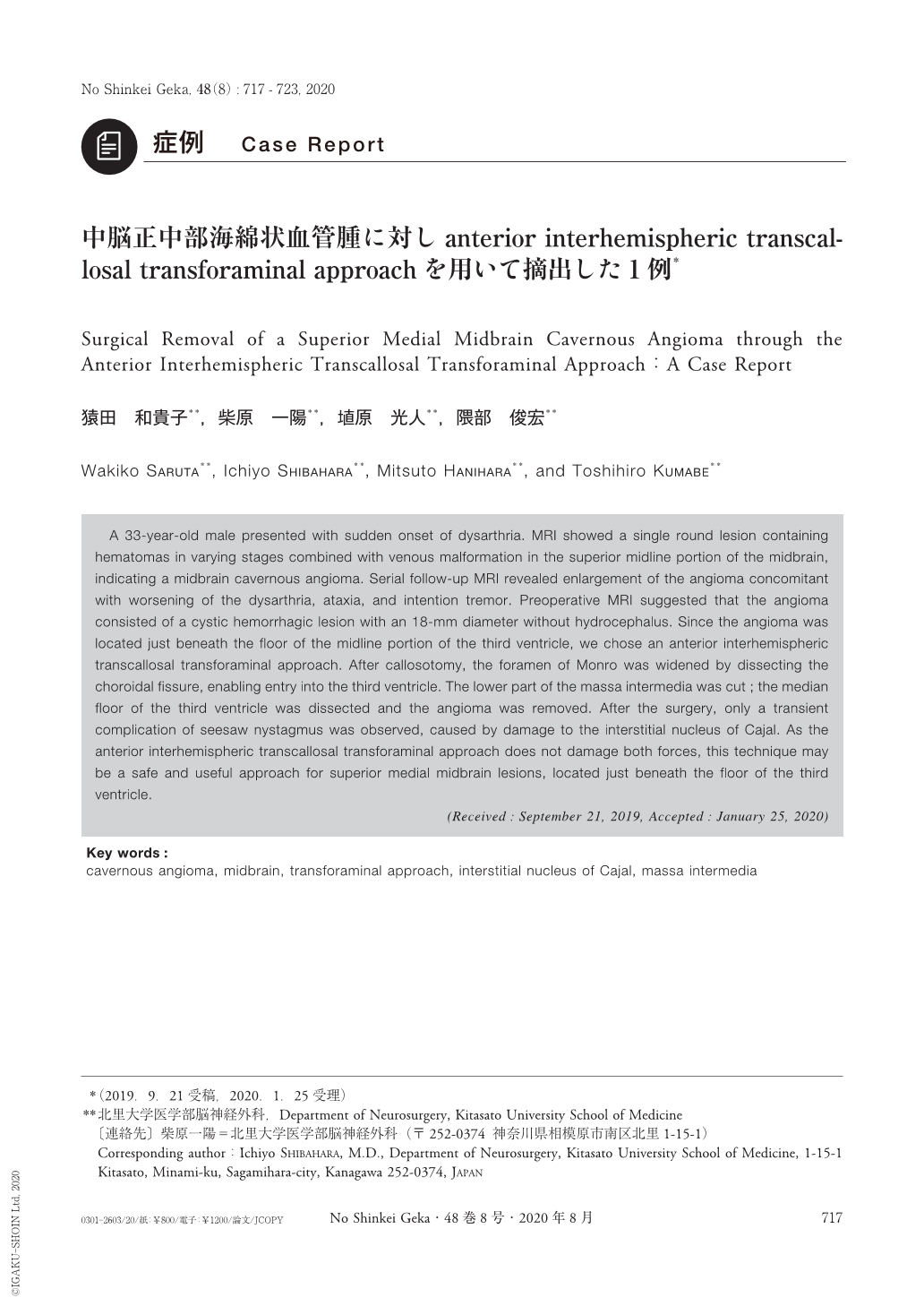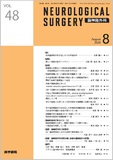Japanese
English
- 有料閲覧
- Abstract 文献概要
- 1ページ目 Look Inside
- 参考文献 Reference
Ⅰ.はじめに
海綿状血管腫は血管奇形の一種で,中枢神経系に発生する血管奇形の10〜15%を占め,好発年齢は40〜50歳台とされている14).部位別発生頻度は脳の容量に比例していると考えられ,テント上の発生頻度が80%程度であるのに対し,テント下では20%程度である1,13).テント下の中でも橋と小脳に発生するものが大半で,中脳に発生するものは比較的稀である13).
中脳は脳深部に存在し,神経核や錐体路を含む神経機能の集合体である.ゆえに,中脳海綿状血管腫は出血により多様な症状を呈し10),同部位に対する手術は難易度が高くなる.『脳卒中治療ガイドライン2015』では,症候性海綿状血管腫(出血,コントロール不良な痙攣,進行性の神経症状)のうち,病変が脳幹を含む脳表付近に存在する症例では外科的切除を考慮してもよい(グレードC1)とされている.しかしながら,中脳海綿状血管腫に対する手術に確立されたアプローチ法はなく,血管腫の局在を見極め,神経機能の障害が最も少ないという観点から,前頭側頭開頭眼窩頬骨弓アプローチ(orbitozygomatic approach),前方経椎体骨アプローチ(anterior transpetrosal approach),側頭下アプローチ(subtemporal approach),後頭部経テントアプローチ(occipital transtentorial approach),外側後頭下アプローチ(lateral suboccipital approach),正中後頭下アプローチ(midline suboccipital approach),そして,テント下アプローチ(infratentorial approach)などが考慮される12,15,17).
今回われわれは,中脳正中部,特に中脳上部に発生した海綿状血管腫に対し,前方半球間裂経脳梁経モンロー孔アプローチ(anterior interhemispheric transcallosal transforaminal approach)を用いて摘出した症例を経験したので報告する.
A 33-year-old male presented with sudden onset of dysarthria. MRI showed a single round lesion containing hematomas in varying stages combined with venous malformation in the superior midline portion of the midbrain, indicating a midbrain cavernous angioma. Serial follow-up MRI revealed enlargement of the angioma concomitant with worsening of the dysarthria, ataxia, and intention tremor. Preoperative MRI suggested that the angioma consisted of a cystic hemorrhagic lesion with an 18-mm diameter without hydrocephalus. Since the angioma was located just beneath the floor of the midline portion of the third ventricle, we chose an anterior interhemispheric transcallosal transforaminal approach. After callosotomy, the foramen of Monro was widened by dissecting the choroidal fissure, enabling entry into the third ventricle. The lower part of the massa intermedia was cut;the median floor of the third ventricle was dissected and the angioma was removed. After the surgery, only a transient complication of seesaw nystagmus was observed, caused by damage to the interstitial nucleus of Cajal. As the anterior interhemispheric transcallosal transforaminal approach does not damage both forces, this technique may be a safe and useful approach for superior medial midbrain lesions, located just beneath the floor of the third ventricle.

Copyright © 2020, Igaku-Shoin Ltd. All rights reserved.


